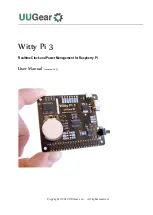
South Bend, Indiana USA
|
networketi.com
PAVEMENT SENSOR INSTALLATION MANUAL | PART NO.
23974
REV
A
2
INSTALLATION INSTRUCTIONS
1 Lay out the sensor housing units or floor boxes
according to your plan for the size and shape of the
pavement area and traffic overflow area.
2. Using a screwdriver or similar tool, remove the
desired knockout seal(s) from the floor boxes. They
won’t all be used. Knock out one of the two bottom
seals in each floor box, as well, for greater stability as
described in step 5 below.
3. With the cap off, rotate each of the three height
adjustment screws to the left to raise the height
adjustment ring between an 1/8 and a 1/4 of an
inch. Put caps back on housing units using the three
retaining screws from the accessory kit.
4. Once the adjustment ring has been raised, apply a
layer of grease to the outside of the sensor housing
body underneath the height adjustment ring. Also
apply grease to the adjustment ring itself. Applying
plenty of grease ensures the continued and proper
operation of the height adjustment ring after the
pavement sets up and cures.
5. Run PVC conduit between the floor box ports opened
in step 2, as well as one for the control box wiring.
Use PVC glue to secure the PVC conduit in place
inside each housing unit port. If not being used for
wiring, it is recommended one of the two bottom
ports be used as a drain with a short piece of conduit
extending down past the concrete into sand or gravel.
This promotes draining and provides greater stability
for each floor box. Refer to Figure 1.
6. As the paving material is poured and sets up,
make sure the caps of all of the housing units are
flush with the pavement. There must be no paving
material on the caps of the housing units. Adjust the
height flush with the pavement by using the height
adjustment ring.
7. To install a sensor into a housing unit, first select
the sensor housing unit to be fitted with the sensor.
If more than one housing unit has been placed as
part of the installation, itis best to select the one it is
believed will be closest to thecenter of the traffic or
snow build-up pattern(s).
8. The next step will be to remove the housing cap and
install the actual sensor. Refer to the documentation
accompanying the sensor for further instructions.
QUESTIONS AND COMMENTS
For technical help, questions, or comments concerning
this or any Environmental Technology, Inc. product,
contact the Customer Service Department between 8:00
a.m. and 5:00 p.m. EST.
E-mail:
LIMITED WARRANTY
ETI’s two year limited warranty covering defects in
workmanship and materials applies. Contact Customer
Service for complete warranty information.
DISCLAIMER
Environmental Technology, Inc. makes no representations
or warranties, either expressed or implied, with respect
to the contents of this publication or the products that
it describes, and specifically disclaims any implied
warranties of merchantability or fitness for any particular
purpose. Environmental Technology, Inc. reserves the
right to revise this publication, and to make changes
and improvements to the products described in this
publication, without the obligation of Environmental
Technology, Inc. to notify any person or organization of
such revisions, changes or improvements.
Copyright © 2019 ETI,
®
All rights reserved.




















